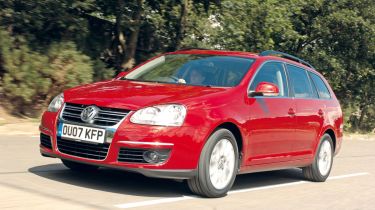Volkswagen Golf
Long awaited Golf estate is a comfortable cruiser, but falls short on space

It has taken a while, but at last the Golf Estate is here. Has it been worth the wait? Well, as with previous versions, it’s a spacious and comfortable load-lugger. In fact, it’s very similar to the hatchback, except with a bigger boot. While we have some reservations about the styling and wish VW had tried harder to make it more versatile, the Estate is still a welcome addition to the Golf range, and a fine no-nonsense purchase.
If ever a range of family cars had something for everyone, it’s Volkswagen’s Golf line-up. As well as three and five-door hatchbacks, there’s the Jetta saloon, high-roofed Plus, Touran MPV, Eos convertible and forthcoming Tiguan SUV.
Despite so many different derivatives, there is one notable gap – a genuine estate. But finally, three years after the latest Golf was originally launched, it has arrived. Is it a worthy addition to the already long line-up?
From a styling point of view, maybe not. It’s fine from the front, where the familiar Golf face gets a chrome grille, and a pair of rails are added to the roof. But the bland tail-lights and sloping tailgate don’t fit in with other VW models in the range. By comparison, the Passat Estate is far more handsome.
Still, the Golf is spacious. It has the same wheelbase as the hatch, but there’s an extra 35cm added from the C-pillars back. Thanks to this extended tail, the Estate will have more than enough room for most. With the rear seats in place, the boot capacity is 505 litres, which is bigger than its Ford Focus and Vauxhall Astra rivals can offer. Fold the bench flat and capacity increases to 1,550 litres, but that is some way behind the ultimate compact family estate, the Peugeot 307 SW, which has a huge 2,002 litres with the seats tucked away.
And the Golf’s practicality isn’t quite as impressive as you might expect. The load space is level and there’s no wheelarch intrusion, but access is hindered by a high boot lip. What’s more, although there’s a handy underfloor storage area along with a 12V socket, the Passat’s clever luggage-securing system isn’t available, so you have to make do with a net and tie straps to secure loads.
You can split the rear seats 60:40, but must remove the headrests to fold them flat, which is slightly fiddly. Maximum load length is 1.74 metres.
Inside, the cabin is identical to the hatchback, with a classy dashboard made of high-quality materials. It won’t win any design awards for innovation, but it’s logically laid out and as all models – S, SE and Sportline – get six airbags and air-con as standard, equipment is generous too. Our SE-spec car also added automatic headlights, rain-sensing wipers and cruise control to the list.
On the road, the Estate drives much like any other Golf. The longer bodywork and slightly increased kerbweight mean it feels a bit slower to respond to steering inputs and generally isn’t as nippy. However, it is still a highly competent cruiser, with a comfortable ride and excellent stability at speed.
The Golf is available with a 101bhp 1.6-litre FSI petrol and VW’s latest turbocharged and supercharged 138bhp 1.4-litre TSI petrol unit. The diesel line-up is topped by a 138bhp 2.0-litre TDI with our test car’s 104bhp 1.9-litre powerplant the entry-level oil-burner.
As with the rest of the Golf range, the Estate comes with either a six-speed manual or DSG twin-clutch sequential gearbox. The 1.9 TDI driven here is expected to be the best-selling Estate, and with plenty of overtaking urge, plus economy of 54.3mpg and CO2 emissions of 137g/km, it makes a lot of sense. However, it’s noisy and unrefined.
Prices start at £14,347 for the 1.6 FSI S, and rise to £20,417 for the 2.0 TDI Sportline. Sitting somewhere in the middle, the 1.9 TDI SE is the pick of the range. But it’s worth considering that the Kia Cee’d SW we drove last week (Issue 973) has more space, power and equipment – and all for around £1,000 less.
Rival: Kia Cee’d SW 2.0 CRDi
You don’t get the badge kudos of the Golf, but if that’s not a concern, the SW is a winner. It looks great, offers 1,664 litres of boot space with the seats down and the 138bhp 2.0-litre diesel model should cost around £15,500.


